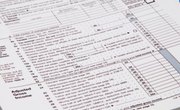The IRS (Internal Revenue Service) introduced a new version of Form W-4, Employee’s Withholding Certificate in late 2019. It included significant revisions to the form starting in 2020. These changes were designed to make the form easier for employees to fill out so the amount of income tax withholding would be correct.
How Form W-4 has Changed
Form W-4 has been updated in several ways. Starting with the 2020 version, employees only fill out one page. The package includes instructions, along with worksheets and tables. Instead of employees having to choose the correct withholding allowances for their tax situation, they complete a five-step process on the form to identify sources of additional income.
Form W-4 and Withholding Allowances
According to the IRS, taxpayers no longer claim personal exemptions or dependency exemptions. The W-4 form was updated to comply with the tax code changes contained in the Tax Cuts and Jobs Act. The new version of the form does not have withholding allowances. These were linked to a taxpayer’s personal exemption amount and are no longer used to make the form simpler and more accurate.
Employees no longer have to use worksheets to determine which claim code is appropriate for their tax situation. Instead, they are asked to answer a series of questions on the form.
Questions on Form W-4
This form asks employees to provide some personal information so that their withholding can be calculated correctly. The questions cover these details:
- Does the employee work more than one job?
- Does the employee’s spouse work?
- Does the employee have any dependents (children under age 17)?
- If the employee has dependents, how many do they have?
- Does the employee have income that does not come from employment (interest, dividends, retirement income)?
Form W-4 and Employee Privacy
The employee has choices about how much information they wish to provide to the employer. (An employee with a simple tax situation may also choose this option.) Only these steps must be completed for a Form W-4 to be considered complete:
- Step 1: Personal Information (Name, Address, Social Security Number, Filing Status)
- Step 5: Sign here. The employee must complete the form by providing a signature.
The employer will then calculate the employee’s withholding based on the employee’s filing status, standard deduction and tax rates without making any further adjustments.
Form W-4 has been updated in several ways. Starting with the 2020 version, employees only fill out one page.
Increase or Decrease Employee Withholding
Employees also have the option to either increase or decrease the amount of their withholding. According to the IRS, it’s generally a good idea to consider increasing withholding if you have two (or more jobs) or if your spouse also works. You should also consider this step if you have self-employment income or other income where no taxes are withheld.
In a situation where you are eligible for the child tax credit, the credit for other dependents or other income tax credits, you should consider decreasing your employee withholding. If you are eligible for itemized deductions, student loan interest deduction, IRA contribution deduction, etc., you should also consider this step.
Points for Employers
The following are important points employers need to keep in mind regarding the Revised 2020 Form W-4 for their employees.
- Any employees starting work after January 1, 2020, fill out the latest version of the form.
- Current employees who wish to make adjustments to their employment withholding also use the updated version of the form.
If an employee does not wish to adjust their withholding with the revised form, an employer can calculate their withholding based on the information taken from the most recent Form W-4 submitted.
References
Writer Bio
Jodee Redmond is a freelance writer, blogger and editor who has been working full-time for over 15 years. She is a graduate of Centennial College and has worked as a tax consultant and a legal assistant. Her previous experience and boundless curiosity is a distinct advantage when writing about such varied topics as income tax, insurance, commercial property, business, construction, addiction, freelance writing and more.
